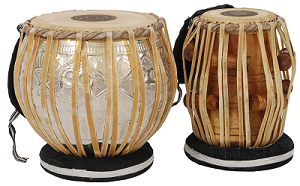The tabla (or tabl, tabla) is a membranophone percussion instrument which is often used in Hindustani classical music and in traditional music of India, Pakistan, Afghanistan, Nepal, Bangladesh and Sri Lanka. The instrument consists of a pair of hand drums of contrasting sizes and timbres.
Tabla playing is a mathematically calculated process. The right hand drum is called a tabla and the left hand drum is called a dagga or baya. It is claimed that the term tabla is derived from an Arabic word, tabl, which simply means “drum.” The tabla is used in some other Asian musical traditions outside of Indian subcontinent, such as in the Indonesian dangdut genre. Playing technique involves extensive use of the fingers and palms in various configurations to create a wide variety of different sounds and rhythms, reflected in the mnemonic syllables (bol). The heel of the hand is used to apply pressure or in a sliding motion on the larger drum so that the pitch is changed during the sound’s decay. In playing tabla there are two ways to play it: band bol and khula bol.In sense of classical music it is termed as “tali” and “khali”.
The smaller drum, played with the dominant hand, is sometimes called dayan (literally “right”), dāhina, siddha or chattū, but is correctly called the “tabla.” It is made from a conical piece of mostly teak and rosewood hollowed out to approximately half of its total depth. The drum is tuned to a specific note, usually either the tonic, dominant or subdominant of the soloist’s key and thus complements the melody. The tuning range is limited although different dāyāñs are produced in different sizes, each with a different range. Cylindrical wood blocks, known as ghatta, are inserted between the strap and the shell allowing tension to be adjusted by their vertical positioning. Fine tuning is achieved while striking vertically on the braided portion of the head using a small, heavy hammer.
The larger drum, played with the other hand, is called bāyāñ (literally “left”) or sometimes dagga, duggī or dhāmā. The bāyāñ has a much deeper bass tone, much like its distant cousin, the kettle drum. The bāyāñ may be made of any of a number of materials. Brass is the most common, copper is more expensive, but generally held to be the best, while aluminum and steel are often found in inexpensive models. Sometimes wood is used, especially in old bāyāñs from the Punjab. Clay is also used, although not favored for durability; these are generally found in the North East region of Bengal.
